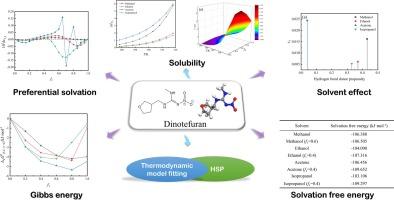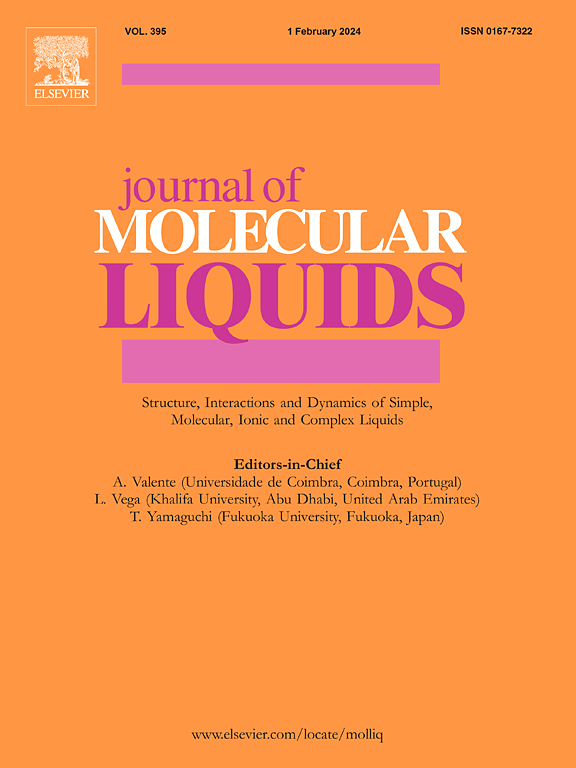通过热力学分析和分子动力学模拟了解克芜踪的固液平衡行为
IF 5.3
2区 化学
Q2 CHEMISTRY, PHYSICAL
引用次数: 0
摘要
克百威是第三代烟碱类杀虫剂,杀虫谱广,对人类和其他哺乳动物毒性低,市场潜力巨大。对第诺特呋喃在各种溶剂中的固液平衡行为的深入了解可以进一步指导进一步结晶工艺的设计、开发和完善。然而,溶解过程的复杂性和多变性使其研究极具挑战性。本研究通过实验和分子动力学模拟相结合的方法,系统研究了地诺呋喃在单溶剂和混合溶剂中的固液平衡。结果表明,随着温度的升高,第诺特呋喃在单溶剂中的溶解度增大,而在混合溶剂中的溶解度则随着有机溶剂摩尔分数的增加先增大后减小。然后用五种热力学模型对实验数据进行了拟合。NRTL 模型的 102ARD 值和 104RMSD 值最低,表明其相关性、有效性和拟合性最好。通过计算热力学性质,研究了地诺呋喃的溶解行为。结果表明,除异丙醇+水混合溶剂外,地诺呋喃的溶解是一个自发的、无序度增加的过程,溶解是一个放热过程。此外,还研究了溶剂的理化性质对第诺特呋喃溶解过程的影响,尤其关注了溶剂极性的关键作用。此外,还进一步计算了地诺呋喃在溶剂中的汉森溶解度和优先溶解参数,以分析溶解过程。在所研究的混合溶剂中,当甲醇、乙醇、异丙醇和丙酮的比例分别达到 0.85、0.75、0.50 和 0.70 时,地诺呋喃分子会优先被水分子溶解。最后,分子动力学模拟揭示了地诺呋喃的溶解机理,表明溶质与溶剂的相互作用越大,溶解越容易。这些固液平衡数据可为开发环境友好型高效制剂提供指导。本文章由计算机程序翻译,如有差异,请以英文原文为准。

Toward understanding the solid-liquid equilibrium behavior of dinotefuran by thermodynamic analysis and molecular dynamic simulation
Dinotefuran is a third-generation nicotinic insecticide with a wide insecticidal spectrum and low toxicity to humans and other mammals, which has a huge potential market. The insight into the solid–liquid equilibrium behavior of dinotefuran in various solvents could further guide the design, development, and refinement of the further crystallization process. However, the complexity and variability of the dissolution process make it very challenging to study. In this research, the solid–liquid equilibrium of dinotefuran in both mono-solvents and mixed solvents was systematically investigated through a combined approach of the experimentation and molecular dynamics simulation. Firstly, the solubility of dinotefuran in a range of solvents was ascertained using the laser dynamic monitoring method over spanning temperatures from 278.15 to 318.15 K. The results showed that the solubility of dinotefuran in mono-solvents increase with the temperature increasing, while the solubility in mixed solvents exhibited an initial increase followed by a decrease with the organic solvent molar fraction increasing. Then the experimental data were fitted using five thermodynamic models. The NRTL model has the lowest 102ARD and 104RMSD values, indicating the best correlation, validity and fit. The dissolution behavior of dinotefuran was explored by calculating the thermodynamic properties. The results indicated that dinotefuran dissolution was a spontaneous, disorder degree increase process, and dissolution an exothermic process except the isopropanol + water mixed solvents. Additionally, the influence of the physicochemical properties of the solvent on the dinotefuran dissolution process was investigated, with a particular focus on the critical role of solvent polarity. Hansen solubility and the preferred solvation parameters of dinotefuran in the solvents were also further calculated to analyze the dissolution process. For the studied mixed solvents, when the ratios of methanol, ethanol, isopropanol, and acetone reached 0.85, 0.75, 0.50, and 0.70, respectively, dinotefuran molecules turned to be preferentially solvated by the water molecules. Finally, molecular dynamics simulation was performed to reveal the mechanisms of dinotefuran dissolution, suggesting the greater solute–solvent interaction, the easier dissolution. The solid–liquid equilibrium data might provide a guidance for the development of environment-friendly and efficient formulation.
求助全文
通过发布文献求助,成功后即可免费获取论文全文。
去求助
来源期刊

Journal of Molecular Liquids
化学-物理:原子、分子和化学物理
CiteScore
10.30
自引率
16.70%
发文量
2597
审稿时长
78 days
期刊介绍:
The journal includes papers in the following areas:
– Simple organic liquids and mixtures
– Ionic liquids
– Surfactant solutions (including micelles and vesicles) and liquid interfaces
– Colloidal solutions and nanoparticles
– Thermotropic and lyotropic liquid crystals
– Ferrofluids
– Water, aqueous solutions and other hydrogen-bonded liquids
– Lubricants, polymer solutions and melts
– Molten metals and salts
– Phase transitions and critical phenomena in liquids and confined fluids
– Self assembly in complex liquids.– Biomolecules in solution
The emphasis is on the molecular (or microscopic) understanding of particular liquids or liquid systems, especially concerning structure, dynamics and intermolecular forces. The experimental techniques used may include:
– Conventional spectroscopy (mid-IR and far-IR, Raman, NMR, etc.)
– Non-linear optics and time resolved spectroscopy (psec, fsec, asec, ISRS, etc.)
– Light scattering (Rayleigh, Brillouin, PCS, etc.)
– Dielectric relaxation
– X-ray and neutron scattering and diffraction.
Experimental studies, computer simulations (MD or MC) and analytical theory will be considered for publication; papers just reporting experimental results that do not contribute to the understanding of the fundamentals of molecular and ionic liquids will not be accepted. Only papers of a non-routine nature and advancing the field will be considered for publication.
 求助内容:
求助内容: 应助结果提醒方式:
应助结果提醒方式:


